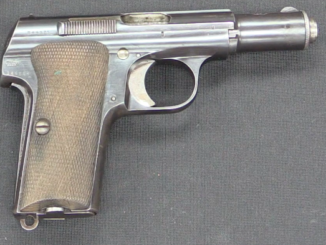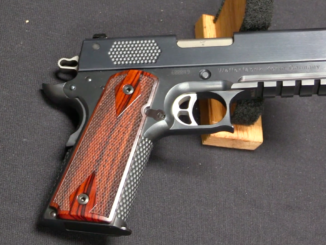Courtesy of the Paul Mauser Archive, we have a very cool opportunity to look at the documentation and paperwork behind a production pistol design, from beginning to commercial sales. This sort of documentation is rare for pre-WW1 German small arms in general, and the Mauser Model 1910 pistol is a very rare example of a complete set of archival papers surviving. So, what we can look at is the whole development process form behind the scenes at Mauser. Initial design drawings, blueprints, glass-plate photography, internal assembly instructions, costing, corporate-level final approval, marketing, and final print manuals. Thanks to Mauro Baudino for supplying these original documents for me to show you!
The Paul Mauser Archive is a wealth of information for researchers, and make sure to check out the recent book on Mauser coauthored by Mauro Baudino and Gerben van Vlimmeren: Paul Mauser: His Life, Company, and Handgun Development 1838-1914.




I’d found your link to the archive just before you put this post up.
It’s really interesting that some of the important documents have survived, ando that there are now researchers who are committed to making them available.
I agree. This knowledge of how things historically developed should be considered public domain. For what it’s worth, the blueprints/technical drawings for some other old weapons like the M1 Garand are publicly available on web archives. I’m not kidding!
Keep in mind that the M1 Garand design was the property of the U.S. government, just like the 1911, the M1 Carbine, the Browning machine guns, and the AR-15 rifle design. They were and are “public domain” because under U.S. law, designs, concepts, or etc. that are “government property” are consider to be the property of the American people as a whole.
This is as true of the Model of 1873 Single Action Army Revolver, aka the “Colt Peacemaker”, as it is of the “Truck, Utility, General Purpose, 1/4 ton, 4 x 4” aka the “Jeep”. In the former case, the only thing Colt actually “owned” was the “rampant colt” trademark. In the latter, the only part of the vehicle which was the “intellectual property” of the Willys-Overland Company was the distinctive seven-barred grille, which to this day is actually a registered trademark along with the word “Jeep” with a capital “J”. It’s the same as the difference between “Deringer” and “derringer”; the former was the trade name of Henry Deringer’s own pistols, the latter is a generic term for any similar compact one or two-shot handgun of the same general type.
As such, you can call any “1/4 ton GP truck, 4 x 4” built for the U.S. government a “jeep”, no matter who actually made it (during the war, a lot were built by Ford, mostly for the Navy and Marines), but a “Jeep” is a specific vehicle name that is a registered trademark, along with the grille, which is considered a “logo”.
The Mauser designs, by comparison, were always the property of the inventor and/or his company. When in 1899-1900, the U.S. created the Springfield rifle as a modified but unlicensed copy of the Mauser model 1898 bolt-action, it was Mauser which sued the U.S. government for patent and copyright infringement, not the German government.
German patent law, and European patent law generally, was considerably more “liberal” than U.S. patent law then and now. Commenting on this effect re liquid rocket propellant development in Germany during WW2, in his book Ignition! (Rutgers U Press, 1971), Dr. John D. Clark noted;
(p.16)
Going back a half-century from Paul Mauser’s time, I’m still surprised that the infamous Rollin White “bored-through cylinder” revolver patent didn’t get White and Smith & Wesson sued into bankruptcy by Lefaucheux and about half the arms makers in Europe.
Not to mention that exactly how White got that patent through in the first place, in light of “prior art”, has never been adequately explained.
cheers
eon
I’d have a big quibble with the idea that the prototype 1902 and the adopted 1903 Springfield rifles were derived from the 1898 Mauser.
You would be a lot closer if you imagined the unfortunate result 9 months later from a very drunken one night stand between a mauser ’94 and an 1892 Krag and jorgenson.
The only piece of a 1903 that might be a reference to the mauser 98, is the reinforcing pad over the right locking lug raceway on the receiver ring. Even then, the large ring mauser 98 had both the simpler machining process and the more functional reinforcement.
Absolutely fascinating and I had no idea that such survived for any guns of that (or indeed any other) period. Being so used to there being little or nothing – don’t you wish there was comparable for countless guns that you could mention (is there any ‘system or measure’ to ensure that similar survives for more modern guns ?).
Drafting a blueprint is less a matter of talent than manual skill, practice, diligence and exactitude, as anyone who has taken mechanical drawing can testify. Every straight line is ruled, every curve is limned with a template or drawing guide. The talented designers have to translate their 3-D ideas into 2-D plans, which in turn are turned into 3-D metal.
Who visits this site and remembers Jim Sullivan’s(?) anecdote about Mr. Ruger spilling a can of franks and beans on the Mini-14 blueprint?
Indeed, drafting including filling notes with proper specifications of material, processing and testing is tedious task. I spent good part of my productive life with it. A bit more enjoyable is prototyping and testing – and back to drawings again for revisions 🙂
One huge advantage people in engineering have now is that paper is secondary; first comes models from which drawings are derived. They can be changed at whim without time consuming redrawing. It’s all about ones and zeroes.
Some might be interested to know that there are shops which do not use paper at all; everything goes from models to programs into finished parts. I have seen one such place – they were involved in fast prototyping for variety of customers.
“Drafting a blueprint is less a matter of talent than manual skill, practice, diligence and exactitude, as anyone who has taken mechanical drawing can testify. Every straight line is ruled, every curve is limned with a template or drawing guide. The talented designers have to translate their 3-D ideas into 2-D plans, which in turn are turned into 3-D metal.”
As mechanical engineer, I think drafting a blueprint needs talent. It does not need that kind of talent, what the drawing and painting needs. A drafter should know how to express ideas with drawings in a decent and efficient way. Drafting is like writing: every people cannot be good writer or poet, and every people cannot be good drafter.
I remember seeing part of engineering documentation for aircraft components by aircraft builder Arado of Germany, either just before war or during. I was surprised with thorough conduct to last detail, no shortcuts. Even drafting vellum was high quality; annotation by templets, just joy to look at.
One of my grandfathers was a draftsman, born in 1899.
I still have some of his drawings on linen, for floating dry docks (there was still one of them in New Zealand a few years ago).
Even in my own career, that includes the end of hand drawing and ammonia copiers, and the beginning of CAD,
There was a great pride in the quality and clarity of drawings that we could produce in a short time.
Some of my grandfather’s drawings became linen tea towels
Thank goodness that Paul Mauser’s and Fidel Federle’s didn’t.
“Really impressive drafting here. You wonder how people did this sort of thing before had CAD/CAM.”
Amazingly decent and beautiful documentation. Now we work with computer, but nearly all documentation what I have ever seen is like a lazy kid’s homework. Bonmot from a veteran mechanical engineer: “Since we have worked with computer, we have time for nothing.”